
Station Name: SIMONSTONE[Source: Andy Hunt}
Simonstone Station Gallery 1: c.1905 - 1956
old1.jpg) In the Edwardian era a lady poses for a photograph in front of Simonstone station. Behind her, the up platform can be seen. The lamp behind her has the words ‘Way to the station’ on the glass. The road to the left is Simonstone Lane. Because of the low embankment here, the road had to dip under the railway bridge. The short road on the other side is the up platform approach road. Note the neat white platform fencing. An Aspinall Class 27 0-6-0 waits with a passenger service for Great Harwood and Blackburn. This class were introduced in 1889 and intended mainly for goods traffic but, obviously, they also worked passenger trains.
Photo from John Mann collection  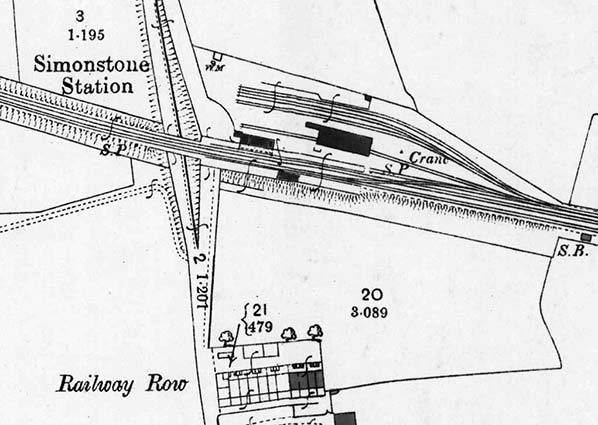
1893 1:2,500 OS map. The station has the original 250 feet platforms, the goods yard can be seen behind the down platform to one side with the small goods shed. One of the 4 sidings runs through the shed, the other 3 are grouped together. All the sidings converge onto one third rail beside the main running lines. This line was in fact a short loop which connected to the main lines at both ends. To the left of the station a bridge carried the line over Simonstone Lane. A weighbridge and weigh office (WM) are located at the entrance to the goods yard.
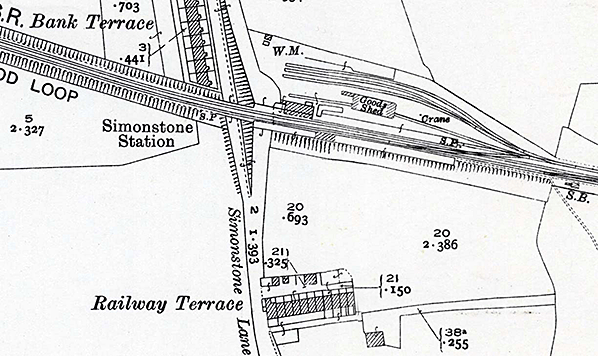 1931 1:2,500 OS map. The platforms have been extended to 395 feet (circa 1904), the station layout is largely unchanged from 1893 however a row of houses called Bank Terrace has now been built along the land and Railway Row has been renamed Railway Terrace. The station was known as “lamp oil junction” due to the fact it had no gas supply. . 1931 1:2,500 OS map. The platforms have been extended to 395 feet (circa 1904), the station layout is largely unchanged from 1893 however a row of houses called Bank Terrace has now been built along the land and Railway Row has been renamed Railway Terrace. The station was known as “lamp oil junction” due to the fact it had no gas supply. .
old2.jpg) A view of both platforms circa 1910, two ladies sit chatting on the down platform while waiting for their train to Rose Grove or Burnley. The station was one of the smallest the L&Y built, the up platform building is a simple shelter mainly built of wood. To the right (out of sight) is the small goods yard. This is what you would have imagined a small country branch line to look like – a view like this would have been typical all over the country. The view is from the up platform looking towards Great Harwood and Blackburn. At the end of the two platforms the bridge can be seen carrying the line over Simonstone Lane, together with a sign on the down platform “BEWARE of the TRAINS”. The stone bridge in the distance carried Gooseleach Lane over the line with Gooseleach Wood behind it. Several pairs of ladders can be seen at various points along the down platform and a large box is resting against the wood fence. Next to it on the left is the gate for access to the goods yard. Ashes look to have been spread over the tracks up to sleeper level. Behind the photographer but out of sight was the signal box standing by the up line. Note the long shadow across the tracks; it looks like this photo was taken late afternoon.
Copyright photo from John Alsop collection old3.jpg)
Smile please. The staff at Simonstone station sit for a group photo circa 1910. The gentleman third from the right is the station master. The wooden bench they are sitting on looks to have been borrowed from the general waiting room. This photo was taken from the Blackburn end of the down platform which has recently been extended, the view is facing east. Suspended from the building's awning are two oil lamps for lighting, and the gate behind them to the left is the exit gate. The reason for the photo is unknown.
Photo from John Mann collection old5.jpg)
The station master and staff pose for the photo on the down platform c1910. Various advertisements can be seen including one for Hudson's soap. To the right, behind the building, the small wooden goods shed can be seen. The lamps here were oil lit as there was no gas supply to the station – it was colloquially known as “lamp oil junction” because of this. The platform lamp to the left has “SIMONSTONE” written on the glass. The gate just behind is the exit gate, next to the men's urinals. Note the view is taken from the up side, close to the wooden crossing which gave access to both platforms. The view is from the Blackburn end looking towards Padiham and Rose Grove.
Photo from John Mann collection old7.jpg) A view from a train passing Simonstone station heading west on the up line towards Great Harwood and Blackburn. The station's old LMS Hawkseye name sign is in full view on the down platform at the Blackburn end and the fencing has seen better days. Note the exit gate off its hinges resting against the fencing (bottom left). One platform bench survives and a small pair of platform ladders rests against the down platform building. The platform was low and steps were provided to help any passengers on or off a train here. The building's full length awning has been replaced with a short ugly one that only covers the booking office exit onto the platform. A ladder is leaning against one of the station's lampposts. Looking east beyond the end of the train you can see the cross-over track that allowed access to a short loop and the goods yard. One of the buffers at the western end of this short loop lies at the Padiham end of the down platform, together with the station's home starter signal. Looking further away, an occupation bridge spans the line and gave a farmer and cattle access to the fields either side of the tracks. Just one mile further away lay Padiham. This view is looking back eastwards towards Padiham and Rose Grove. It's a little hard to see from this angle but the advertising boards have the letters LMS on them but they have been painted out. A view from a train passing Simonstone station heading west on the up line towards Great Harwood and Blackburn. The station's old LMS Hawkseye name sign is in full view on the down platform at the Blackburn end and the fencing has seen better days. Note the exit gate off its hinges resting against the fencing (bottom left). One platform bench survives and a small pair of platform ladders rests against the down platform building. The platform was low and steps were provided to help any passengers on or off a train here. The building's full length awning has been replaced with a short ugly one that only covers the booking office exit onto the platform. A ladder is leaning against one of the station's lampposts. Looking east beyond the end of the train you can see the cross-over track that allowed access to a short loop and the goods yard. One of the buffers at the western end of this short loop lies at the Padiham end of the down platform, together with the station's home starter signal. Looking further away, an occupation bridge spans the line and gave a farmer and cattle access to the fields either side of the tracks. Just one mile further away lay Padiham. This view is looking back eastwards towards Padiham and Rose Grove. It's a little hard to see from this angle but the advertising boards have the letters LMS on them but they have been painted out.No one is really sure about the date of this photo, but sometime after 1952 the platform edges here were painted with a white line. The absence of this white line on the platform suggest it's pre 1952, possibly 1950 / 51. Photo from John Mann collection
Click here for Simonstone Station Gallery 2:
|
 The smallest station on the North Lancashire Loop line, and said to be one of the smallest the L&Y built, Simonstone was just 1 mile to the west of Padiham. It was known for the first 30 to 40 years as 'lamp oil junction' because when it was built, and for some time afterwards, it had no gas supply, requiring oil for the lighting.
The smallest station on the North Lancashire Loop line, and said to be one of the smallest the L&Y built, Simonstone was just 1 mile to the west of Padiham. It was known for the first 30 to 40 years as 'lamp oil junction' because when it was built, and for some time afterwards, it had no gas supply, requiring oil for the lighting.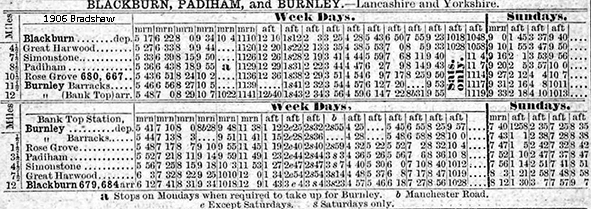

 The goods yard behind the down platform area was entered at the Padiham end by a short loop to the down line via a diamond crossover. Later a trailing crossover was used, giving more options to access the yard. The yard itself had four sidings, with the one nearest the station serving the goods shed. The shed itself was open-fronted and the sides did not reach all the way to ground level. It was built of wood in 1885. The yard also had a crane with a 5 ton lifting capacity. Entrance to the goods yard was from the approach road off Simonstone Lane. The entrance was provided with wooden gates; just inside the gates was a wooden weigh house containing the weighing machine. The weighing machine is reported to have gone by 1934.
The goods yard behind the down platform area was entered at the Padiham end by a short loop to the down line via a diamond crossover. Later a trailing crossover was used, giving more options to access the yard. The yard itself had four sidings, with the one nearest the station serving the goods shed. The shed itself was open-fronted and the sides did not reach all the way to ground level. It was built of wood in 1885. The yard also had a crane with a 5 ton lifting capacity. Entrance to the goods yard was from the approach road off Simonstone Lane. The entrance was provided with wooden gates; just inside the gates was a wooden weigh house containing the weighing machine. The weighing machine is reported to have gone by 1934. 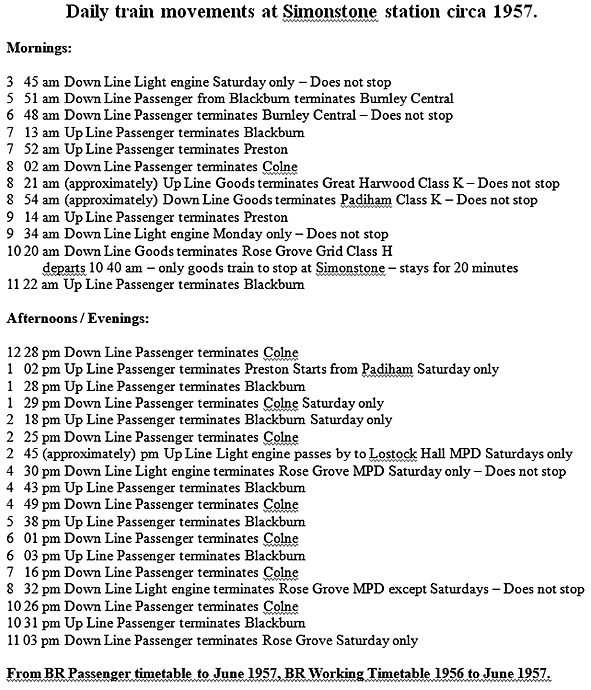
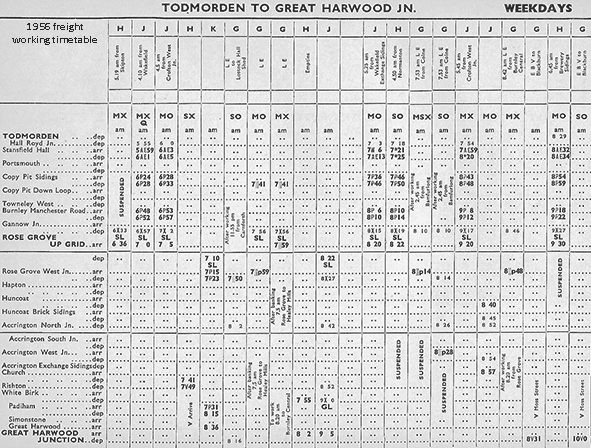
 Why was this station ever built? It's true the village of Read was growing in anticipation of the line coming, and by 1870 the first of two mills was built there. But Read was already served by a road to Padiham, only 1.5 miles away, and the station was not really that much closer, being only 1 mile from Padiham.
Why was this station ever built? It's true the village of Read was growing in anticipation of the line coming, and by 1870 the first of two mills was built there. But Read was already served by a road to Padiham, only 1.5 miles away, and the station was not really that much closer, being only 1 mile from Padiham.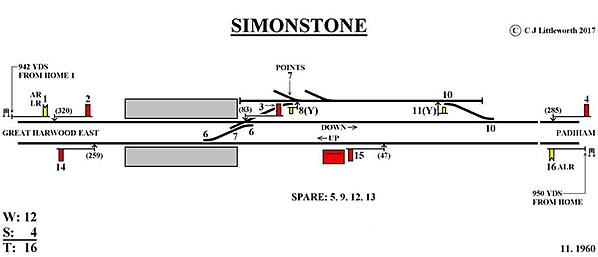 Simonstone signal box, was next to the up (westbound) side of the running lines. It was situated opposite the goods yard entrance and the short loop. The signalling here was fairly simple as the station was only small, the box controlling the section either side of the station and access to the short loop and goods yard. Access to the goods yard via the short loop could be done via the up line or down line. The box (here shown in red) was on the Padiham / Rose Grove side. As of November 1960, it had 12 working levers, 4 spare, making a total of 16 levers. The signal box was brick built with a slate roof and was numbered 334. It closed 2 November 1964 when the line west of Padiham closed.
Simonstone signal box, was next to the up (westbound) side of the running lines. It was situated opposite the goods yard entrance and the short loop. The signalling here was fairly simple as the station was only small, the box controlling the section either side of the station and access to the short loop and goods yard. Access to the goods yard via the short loop could be done via the up line or down line. The box (here shown in red) was on the Padiham / Rose Grove side. As of November 1960, it had 12 working levers, 4 spare, making a total of 16 levers. The signal box was brick built with a slate roof and was numbered 334. It closed 2 November 1964 when the line west of Padiham closed.old6.jpg) Taken in 1952, just five years before closure, the down platform building has lost its full-length wooden awning which has been replaced by a short ugly-looking one supported by two steel girders. This replacement only covered the exit to the booking hall onto the platform. A pair of small steps can be seen for assistance onto a train stemming from the fact the platforms were low. The view was taken from the end of the up platform facing towards Padiham and Rose Grove. On the far right the goods shed can be seen, and the platform gate to the yard is open. The station clock can be seen and looks to say 4.26.
Taken in 1952, just five years before closure, the down platform building has lost its full-length wooden awning which has been replaced by a short ugly-looking one supported by two steel girders. This replacement only covered the exit to the booking hall onto the platform. A pair of small steps can be seen for assistance onto a train stemming from the fact the platforms were low. The view was taken from the end of the up platform facing towards Padiham and Rose Grove. On the far right the goods shed can be seen, and the platform gate to the yard is open. The station clock can be seen and looks to say 4.26.
 Home Page
Home Page